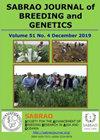IDENTIFICATION AND CHARACTERIZATION OF CASSAVA MUTANT GENOTYPES WITH HIGH LEAF MINERAL CONTENT AT THE MV10 GENERATION
IF 1.7
Q3 PLANT SCIENCES
引用次数: 0
Abstract
Cassava leaves’ consumption as vegetables are common in several Asian countries. They contain various nutrients, such as, anthocyanins, carotene, minerals, and vitamins. New varieties with high mineral contents in leaves need development to increase the leaves’ quality as vegetables. This study aimed to identify and characterize cassava genotypes of the MV10 generation resulting from gammaray- induced mutations based on the leaves' morphology, growth characteristics, and mineral contents, using two cultivars and 10 cassava genotypes. All genotypes planted in a randomized complete block design had three replications. The leaf's morphology and mineral contents underwent scrutiny on the third to fifth leaf below the apical shoot. The mineral content analysis used the Atomic Absorption Spectrophotometry method. Data analysis comprised the ANOVA test and descriptive analysis. This study revealed petiole length, leaf lobe length, and leaf lobe width were significantly different between genotypes at four months after planting (MAP). However, no meaningful difference showed for the plant height, stem diameter, and number of leaves among genotypes. In general, the leaf morphology consisted of purplish green apical leaves with present pubescence; the shape of the central leaflet is lanceolate; the petiole color is reddish to greenish; leaves are dark green with five to seven leaf lobes; leaf veins are reddish-green; smooth lobe margins; and horizontal petiole orientation. The genotypes affect mineral contents, as the genotype with the highest Mg contents was G6-2-15-5-3, and the one with the highest Zn contents was G2D1-422. Fe contents showed more variations between genotypes, and no genotype showed consistently high Fe contents. This research produced promising genotypes for Mg or Zn contents in leaves for future cassava varieties for vegetable production.木薯mv10代高叶矿物质含量突变体基因型的鉴定与特性研究
木薯叶作为蔬菜食用在几个亚洲国家很常见。它们含有多种营养成分,如花青素、胡萝卜素、矿物质和维生素。为提高蔬菜叶片的品质,需要培育富含矿物质的新品种。本研究利用两个品种和10个木薯基因型,基于叶片形态、生长特征和矿物质含量,对伽玛射线诱导突变后的MV10代木薯进行基因型鉴定和鉴定。所有基因型采用随机完全区组设计,重复3次。在根尖以下的第3 ~ 5片叶片上观察叶片的形态和矿物质含量。矿物含量分析采用原子吸收分光光度法。数据分析包括方差分析和描述性分析。结果表明,在植后4个月,不同基因型间叶柄长度、叶片长度和叶片宽度存在显著差异。株高、茎粗、叶数在不同基因型间无显著差异。总体上,叶形态为紫绿色的顶叶,有短柔毛;中央小叶的形状是披针形的;叶柄颜色微红到淡绿色;叶是深绿色的,有五到七个叶裂片;叶脉是红绿色的;光滑的裂片边缘;和水平的叶柄方向。矿质元素含量受基因型影响,Mg含量最高的基因型为G6-2-15-5-3, Zn含量最高的基因型为G2D1-422。铁含量在不同基因型之间存在较大差异,没有一个基因型的铁含量始终较高。本研究为未来蔬菜木薯品种的叶片Mg或Zn含量提供了有前景的基因型。
本文章由计算机程序翻译,如有差异,请以英文原文为准。
求助全文
约1分钟内获得全文
求助全文
来源期刊

Sabrao Journal of Breeding and Genetics
农林科学-奶制品与动物科学
CiteScore
1.90
自引率
50.00%
发文量
63
期刊介绍:
The SABRAO Journal of Breeding and Genetics is an international journal of plant breeding and genetics research and was first published in 1969. It is the official publication of the Society for the Advancement of Breeding Research in Asia and Oceania (SABRAO).
Its objectives are to: promote the international exchange of research information on plant breeding and genetics, by describing new research findings, or ideas of a basic or practical nature; and be a medium for the exchange of ideas and news regarding members of the Society.
The Journal gives priority to articles that are of direct relevance to plant breeders and with emphasis on the Asian region. Invited for publication are research articles, short communications, methods, reviews, commentaries, and opinion articles. Scientific contributions are refereed and edited to international standards.
The journal publishes articles for SABRAO members mainly. The Journal preferred strongly that at least one author should be a current member of the Society. Non-members may also publish in the journal.
 求助内容:
求助内容: 应助结果提醒方式:
应助结果提醒方式:


